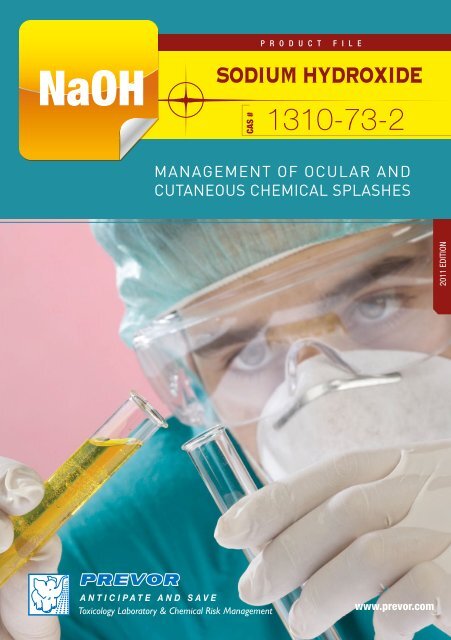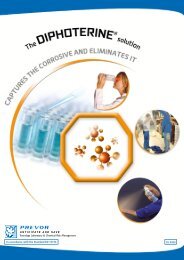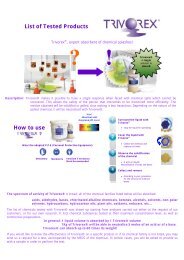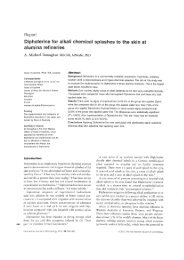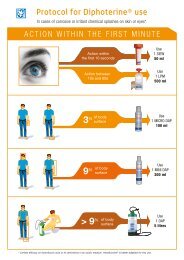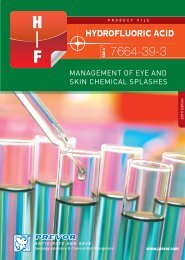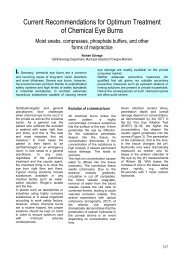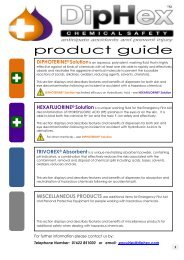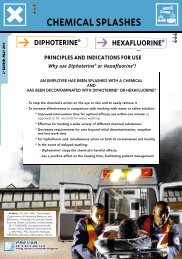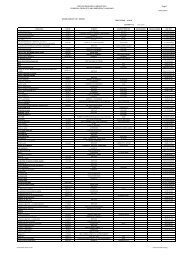Sodium Hydroxide Booklet - DipHex
Sodium Hydroxide Booklet - DipHex
Sodium Hydroxide Booklet - DipHex
You also want an ePaper? Increase the reach of your titles
YUMPU automatically turns print PDFs into web optimized ePapers that Google loves.
NaOH<br />
SODIUM HYDROXIDE<br />
CAS #<br />
P R O D U C T F I L E<br />
1310-73-2<br />
MANAGEMENT OF OCULAR AND<br />
CUTANEOUS CHEMICAL SPLASHES<br />
2011 EDITION<br />
ANTICIPATE AND SAVE<br />
Toxicology Laboratory & Chemical Risk Management<br />
www.prevor.com
NaOH<br />
Sommaire<br />
<strong>Sodium</strong> hydroxide<br />
MANAGEMENT OF OCULAR AND<br />
CUTANEOUS CHEMICAL SPLASHes<br />
1. Key points p3<br />
1.1 History p3<br />
1.2. Names and formula p3<br />
1.3. Use p3<br />
2. Labelling p4<br />
2.1. Hazard level according to concentration p4<br />
2.2. Other classifications p5<br />
3. Chemical properties p5<br />
4. Corrosivity of sodium hydroxide p7<br />
4.1. Chemical mechanisms p7<br />
4.2. Chemical lesions due to sodium hydroxide p8<br />
5. Management of the corrosive risk due to sodium hydroxide p13<br />
6. Emergency care management of a sodium hydroxide splash p13<br />
6.1. Evaluation of washing methods p13<br />
6.2. Experimental evidence of effectiveness p15<br />
6.3. Feedback on the use of Diphoterine ® p17<br />
7. Advices and indications about the use of Diphoterine ® p22<br />
8. Documentary references p23<br />
2<br />
MANAGEMENT OF OCULAR AND CUTANEOUS CHEMICAL SPLASH
1. Key points<br />
1.1. History<br />
<strong>Sodium</strong> hydroxide derives from sodium carbonate, formerly named “caustic soda”. In Ancient Egypt,<br />
sodium carbonate was already mixed with lime to synthetize an alkali: the hydroxide ion OH - in solution<br />
with the sodium ion Na + . Through the ages, several processes were developed to synthetize it, such<br />
as the Solvay process in 1861. Today, sodium hydroxide is mostly produced by the electrolysis of a<br />
solution of sodium chloride.<br />
1.2. Dénominations et formule<br />
- <strong>Sodium</strong> hydroxide<br />
- Lye<br />
- Caustic soda<br />
- Alkaline drain cleaner (in solution)<br />
- <strong>Sodium</strong> hydrate<br />
- Ascarite<br />
<strong>Sodium</strong> hydroxide<br />
Formula NaOH<br />
Molar mass 40 g.mol -1<br />
CAS number 1310-73-2<br />
EINECS number 215-185-5<br />
ICSC number (1) 0360<br />
1.3. Use<br />
<strong>Sodium</strong> hydroxide is one of the most used chemical substances in laboratory and in industrial environment,<br />
in the manufacture of paper pulp and of various chemical products: plastics, synthetic textiles, cleaning<br />
products for both domestic and industrial use, in the production of petrol and biodiesel, of soaps or even<br />
in the aluminum treatment. It is also a food additive (E524).<br />
1 - International Chemical Safety Cards<br />
Product File <strong>Sodium</strong> hydroxide<br />
3
2. Labelling<br />
2.1. Hazard levels according to concentration<br />
• EC classification in force until June 2015 for mixtures.<br />
Product included in CLP00 (2) .<br />
<strong>Sodium</strong> hydroxide hazard symbol Risk phrase<br />
Concentration ≥ 5% C R35<br />
Concentration from 2 to 4,99% C R34<br />
Concentration from 0,5 % to 1,99% Xi R36/38<br />
Concentration < 0,5% - -<br />
Title of risk phrases (EC classification)<br />
R35 : Causes severe burns<br />
R34 : Causes burns<br />
R36/38 : Irritating to eyes and skin<br />
• New labelling according to CLP regulation, mandatory since December 2010 for<br />
substances and from June 2015 for mixtures:<br />
DANGER !<br />
H314 Causes severe skin burns and eye damage<br />
2 - Classification Labelling Packaging –1272/2008/EC regulation<br />
4<br />
<strong>Sodium</strong> hydroxide classification Hazard statements<br />
Concentration ≥ 5% Skin corrosion H314<br />
Category 1A<br />
Concentration from 2 to 4,99% Skin corrosion H314<br />
Category 1B<br />
Concentration from 0,5 % to 1,99% Skin irritation cat. 2 H315<br />
Eye Irritation cat. 2<br />
H319<br />
Concentration < 0,5% - -<br />
MANAGEMENT OF OCULAR AND CUTANEOUS CHEMICAL SPLASH<br />
Hazard statements (CLP regulation)<br />
H314: Causes severe skin burns and eye<br />
damage<br />
H315: Causes skin irritation<br />
H319: Causes serious eye irritation
2.2. Other classification: the American classification<br />
Red 0 - Flammability: non flammable chemical<br />
Blue 3 - Hazard to health: short-time exposure may cause<br />
temporary or persistent serious lesions<br />
Yellow 1 - Reactivity: stable in normal conditions, but may<br />
become instable under high temperatures or<br />
high pressures<br />
White COR - Symbol specific to corrosives<br />
3<br />
0<br />
1<br />
COR<br />
3. Chemical properties<br />
Pure sodium hydroxide is a white solid. It is translucent and very hygroscopic (great ability to attract and<br />
hold water molecules). It reacts easily with the water from the air or from any wet surface (phenomenon<br />
of deliquescence). The dissolving of caustic soda in water may be accompanied by heat release (Figure 1).<br />
45<br />
40<br />
T (°C)<br />
35<br />
30<br />
25<br />
20<br />
200 400 600 800 1000 1200 1400 1600 1800<br />
Time (s)<br />
Figure 1: Temperature evolution during the dissolving of 1g<br />
of sodium hydroxide chips, in water<br />
Product File <strong>Sodium</strong> hydroxide<br />
5
It is sold as: chips, flakes, granules, blocks, cubes or in aqueous solution. In the industrial environment, the<br />
most concentrated liquid form of sodium hydroxide is 50%, but then it is very viscous (Figure 2).<br />
Water<br />
1 cP (centipoise)<br />
24% sodium hydroxide 7,1 cP<br />
50% sodium hydroxide 78 cP<br />
Olive oil<br />
800-1000 cP<br />
Examples of viscosity at 20°C<br />
Dynamic viscosity depending on NaOH<br />
concentration<br />
90<br />
Dynamic viscosity (cP - centipoise)<br />
80<br />
70<br />
60<br />
50<br />
40<br />
30<br />
20<br />
10<br />
0<br />
10 20 30 40 50 60<br />
{NaOH} (%w/w)<br />
Figure 2 : Evolution of the viscosity of a sodium hydroxide<br />
solution in relation with its concentration - Source: Handbook<br />
87th issue 2006/2007 and Cèdre-2005<br />
6<br />
MANAGEMENT OF OCULAR AND CUTANEOUS CHEMICAL SPLASH
Molar mass 40 g.mol -1<br />
Boiling point 1 390°C<br />
Melting point 318°C<br />
Vapour pressure 0,13 kPa at 739°C<br />
2,67 kPa at 953°C<br />
13,3 kPa at 1 111°C<br />
53,3 kPa at 1 286°C<br />
Specific gravity 2,13<br />
Solubility in water (20°C) 109 g/100 mL<br />
VME (3) 2 mg/m 3 (4)<br />
PEL (TWA) (5) 2 mg/m 3<br />
STEL (TWA) (6) -<br />
Source: Toxicological sheet from INRS and ICSC sheet<br />
4. Corrosivity of sodium hydroxide<br />
4.1. Chemical mechanisms<br />
<strong>Sodium</strong> hydroxide is an alkali (strong base) because it dissociates completely in aqueous environment<br />
and thus releases the OH- ion.<br />
H2O<br />
NaOH Na + + OH- pK a = 14,8<br />
The carbon dioxide from the air can dissolve in aqueous environment and react with sodium hydroxide<br />
to produce carbonates.<br />
OH - (aq) + CO2 (g) HCO3 - H + + CO3 2-<br />
3 - French Occupational Exposure Limit<br />
4 - In France, it is an indicative value<br />
5 - Permissible Exposure Limit (Exposure limit value in a 8 hour day allowed by the Occupational Safety Health Administration)<br />
6 - Short-Term Exposure Limit (Limit value for an exposure of less than 15 minutes, according to the OSHA)<br />
Product File <strong>Sodium</strong> hydroxide<br />
7
The pH of the solution changes and depends on the balance with the CO 2, HCO 3<br />
- and<br />
CO 3<br />
2- ions.<br />
<strong>Sodium</strong> hydroxide oxidizes several metals with the emission of an explosive gas: the<br />
dihyrogen (H 2).<br />
For instance, with zinc:<br />
Zn + 2 NaOH (aq) -> H 2 (g) + Na 2Zn(OH) 4 (aq)<br />
aq: aqueous solution<br />
s: solid form<br />
g: gaseous form<br />
4.2. Chemical lesions due to sodium hydroxide<br />
The great availability and the multiple utilizations of sodium hydroxide, both in the domestic and in the<br />
industrial environments, explain the frequency of the risk of accidental or deliberate chemical lesions.<br />
Lesions may damage the skin, the eyes, the digestive system or the respiratory tract.<br />
This file deals with cutaneous and ocular lesions.<br />
The only danger of sodium hydroxide is corrosion /irritation which occurs for concentrations above<br />
0.5%.<br />
4.2.1. Skin exposure<br />
In contact with skin, sodium hydroxide causes a liquefaction necrosis with the saponification of the liquid<br />
cell membranes and the dissolution of the tissue proteins (Palao - 2010).<br />
8<br />
MANAGEMENT OF OCULAR AND CUTANEOUS CHEMICAL SPLASH
Lesions are characterized by a brown coloration and a gelatinous appearance. It is associated with pain,<br />
the precocity and intensity of which depend on the concentration and the time of contact.<br />
Cutaneous lesions may be terebrant (slow penetration and spreading to the deep skin layers).<br />
Figure 3: non-washed caustic soda burn, Source: Dr Lucien Bodson, CHU Liège<br />
(Liège University Hospital), Belgium<br />
An ex vivo experimental study on human skin explants has enabled to follow the spreading and penetration<br />
of 50% caustic soda into skin, thanks to the histological observation of the alterations of the epithelial<br />
and dermal cells.<br />
Exposure time<br />
observation of the lesions<br />
4 minutes A clear cleavage appears in the middle of the stratum corneum (SC).<br />
30 minutes Clear disintegration aspects of the SC, without visible<br />
changes in the alive epidermal structure (Figure 7).<br />
1 hour Clear aspects of lysis of the corneocytes membranes<br />
(SC cells) in the upper SC layers.<br />
2 - 48 hours The lysis of the SC is complete and no cellular life is observed in<br />
the epidermis and in the papillary dermis (the most superficial part<br />
of the sub-epidermal layer - Figure 8). This aspect remains<br />
identical until 48 hours of contact.<br />
Figure 4: Chronology of lesion development on the human skin explants after exposure to 50% caustic soda<br />
Product File <strong>Sodium</strong> hydroxide<br />
9
The very viscous 50% caustic soda penetrates into the stratum corneum in which it accumulates<br />
and causes clear destruction aspects after 30 minutes and afterwards clear aspects of lysis of the<br />
corneocytes membranes after 1 hour. After 2 hours of contact, the penetration of caustic soda into<br />
deep layers is massive and from 2 hours of contact, this fast spreading results in the absence of<br />
cellular life in the epidermis and in the papillary dermis. The kinetics of lesions evolution due to the<br />
exposure to 50% sodium hydroxide is thus very different from what is observed during the exposure<br />
to concentrated acids.<br />
With the same model, 70% hydrofluoric acid penetrates fast and deeply within the first minutes of<br />
contact (Burgher - 2010).<br />
Figure 5: The different skin layers<br />
Figure 6: non-exposed skin explant.<br />
Figure 7: skin explant exposed to 50% NaOH<br />
for 30 minutes. The stratum corneum<br />
is unstructured.<br />
Figure 8: skin explant exposed to 50% NaOH<br />
for 2 hours. Cellular death in the epidermis<br />
and in the papillary dermis.<br />
An unusual lethal case of splash by concentrated caustic soda under heat (at 95°C) has been published<br />
in the literature. The high temperature of the splashed chemical has increased the kinetics of hydroxide<br />
ion penetration into skin tissues and has deeply burnt the victim to the bones in some areas of the body.<br />
The time of contact of the substance with the body has been estimated approximatively at 13 minutes<br />
only. (Lee – 1995)<br />
10 MANAGEMENT OF OCULAR AND CUTANEOUS CHEMICAL SPLASH
4.2.2. Eye exposure<br />
Clinically, in contact with sodium hydroxide, the cornea quickly loses its transparency. As it does for<br />
skin, the OH- ion saponifies the fatty acids from the membranes and thus immediately causes the<br />
corneal epithelial cells death. The continuation of the corrosive spreading through the corneal stroma<br />
and to the anterior chamber of the eye can lead to the lens opacification and, in the most severe cases,<br />
to the complete destruction of the eyeball (Merle - 2008).<br />
In ex vivo or in vitro experiments (Figure 10), the sodium hydroxide spreading can be measured in<br />
relation with the sodium hydroxide concentration or the time of contact. The higher the concentration<br />
of the solution is, the faster the penetration will be.<br />
Thus, a 2 M (2 mol/l) sodium hydroxide solution completely penetrates the cornea within less than<br />
40 seconds (Figure 11). In absence of an efficient and early enough washing, anatomical and functional<br />
lesions may be irreversible (Gérard - 1996).<br />
Nevertheless, below a 0.2 mol/l concentration, only a small penetration occurs and it causes no<br />
observable lesions. (Schrage – 2010).<br />
Figure 9 : Picture of ocular lesions due to an alkaline splash: milky and frosty<br />
aspect of the cornea. (Source: Pr Norbert Schrage, Aix la Chapelle, Germany)<br />
Product File <strong>Sodium</strong> hydroxide<br />
11
14<br />
Diffusion of NaOH through a membrane at 20°C<br />
12<br />
pH<br />
10<br />
8<br />
6<br />
4<br />
0 30 60 90 120 150 180 210 240 270 300<br />
Time (s)<br />
Figure 10: In vitro model of the penetration of caustic soda through<br />
a semi-permeable membrane in relation with its concentration.<br />
NaOH 50%<br />
NaOH 10%<br />
NaOH 4,5%<br />
NaOH 1,5%<br />
NaOH 1%<br />
NaOH 0,5%<br />
pH physiologically<br />
acceptable<br />
500<br />
Penegtration depth (µm)<br />
400<br />
300<br />
200<br />
100<br />
NaOH (1M)<br />
NaOH (2M)<br />
Full penetration of the cornea<br />
0<br />
0 10<br />
20 30 40<br />
Time (s)<br />
Figure 11: Penetration of NaOH through an ex-vivo rabbit cornea in<br />
relation with its concentration – Observation by OCT-HR (7) (Spöler - 2007)<br />
7 - Optical Coherence Tomography – High Resolution<br />
12 MANAGEMENT OF OCULAR AND CUTANEOUS CHEMICAL SPLASH
5. Management of the chemical risk due to sodium hydroxide<br />
> Collective and personal protections (8)<br />
Collective<br />
protection<br />
• Capture of the emissions straight from the source<br />
• Good ventilation<br />
• Avoiding contact from any metallic objet<br />
• Proceeding to industrial operations in isolation<br />
Personal<br />
protection<br />
• Face screens, watertight safety glasses,<br />
appropriate gloves, lab coat, apron …<br />
> Compatibility table for gloves<br />
latex Neoprene Nitrile Vinyle Polyvinyl<br />
(PVC) alcohol (PVA)<br />
<strong>Sodium</strong><br />
hydroxide<br />
+++ +++ +++ ++ -<br />
Source: NIOSH – Pocket guide<br />
> Specific recommendations<br />
It is essential that the sodium hydroxide dissolution in water is done progressively and under agitation<br />
in order to control a potential exothermic reaction.<br />
6. Emergency care management of a sodium hydroxide splash<br />
6.1. Evaluation of washing methods<br />
The danger of caustic soda is corrosion. Washing within the first minute of contact allows to avoid or to<br />
minimize the extent of the lesions.<br />
Ideally the reactivity of the chemical must be stopped in surface before the product penetrates into the<br />
deep layers of the skin or eye. Historically washing with water has been the first significant step for the<br />
management of chemical splash.<br />
8 - Report to complete description in INRS Toxicological Sheet #20 (Fiche Toxicologique INRS n°20) or NIOSH pocket guide<br />
Product File <strong>Sodium</strong> hydroxide<br />
13
In case of an alkali splash, a few publications suggest a specific neutralization by weak acids such as<br />
acetic acid (Andrews - 2002). However, this neutralizing effect could be harmful if it is not thoroughly<br />
controlled (Falcy / INRS - 1997) (Exothermic reaction due to neutralization – acid burn developing after<br />
neutralization of a alkali splash with an acid, for instance).<br />
6.1.1. Washing with tap water<br />
Tap water is a polyvalent solution, which removes a big part of the chemical by a sweeping and diluting<br />
effect at the surface of tissues. However, washing with tap water requires an early intervention using<br />
a very big volume of tap water during a long time (Açikel – 2001, Yano - 1993). The ANSI Z358.1-2004<br />
standard specifies that the showers must be reached within a 10 seconds time limit. Connected to the<br />
water supply network the showers must be able to deliver a 60 L/min flow for 15 minutes (European<br />
standard: EN 15154 -1).<br />
In case of a splash of concentrated corrosives, tap water has sometimes shown some limitations with<br />
the possible development of severe burns due in particular to the lack of chemical action of tap water<br />
on the corrosive potential of caustic soda (O’Donoghue – 1996, Ma – 2007). Following washing with<br />
tap water, some observations mention the need of surgical operations because of the severity of the<br />
lesions resulting from caustic soda splashes (Winder – 1997, Wang – 1992).<br />
6.1.2. Washing with Diphoterine ®<br />
While it keeps the properties of rinsing with tap water, an active washing allows acting on the chemical<br />
directly in order to limit its corrosive effects on the skin or eye.<br />
The physical and chemical properties of Diphoterine ® optimize and secure the effectiveness of the<br />
rinsing.<br />
• Its amphoteric nature enables an extremely rapid return to the physiologically acceptable zone<br />
of pH.<br />
• Its hypertonicity limits the penetration in depth of sodium hydroxide and generates a flow from<br />
the inside to the outside of tissues, and thus it attracts to the outside the quantity of chemical<br />
substance that might have already penetrated. (Schrage - 2004).<br />
• Thanks to its polyvalence and its innocuity (Hall - 2002, Hall - 2009), Diphoterine ® is a premium<br />
decontamination solution, even when caustic soda is combined with other corrosives or irritants.<br />
14 MANAGEMENT OF OCULAR AND CUTANEOUS CHEMICAL SPLASH
6.2. Experimental evidence of effectiveness<br />
Several in vitro and in vivo studies have been realized on the interest of rinsing with Diphoterine ® versus<br />
other rinsing methods after exposure to sodium hydroxide.<br />
6.2.1 in vitro and in vivo experiments<br />
The effectiveness of Diphoterine ® is experimentally compared with rinsing with water by an in vitro<br />
simulation of a splash of (2 mol/L) sodium hydroxide (Blomet - 2008). A model of semi-permeable<br />
membrane is used to represent the cornea. The experiment follows the pH evolution from both sides<br />
of the membrane, in other words: the external pH corresponding to the pH at the surface of the cornea<br />
and the internal pH for the pH of the anterior chamber of the eye (which is simulated by a 14‰ sodium<br />
chloride solution, with the same osmolarity as the aqueous humor of the eye).<br />
Two kinds of experiment have been realized with a contact time of 20 seconds and one of 1 minute<br />
(Mathieu - 2007). Figure 12 shows the evolution of the internal pH.<br />
13<br />
In vitro simulation of complete<br />
washing following a 2N NaOH exposure<br />
12<br />
pH<br />
11<br />
10<br />
9<br />
20 s of contact - Diphoterine ®<br />
1 min of contact - Diphoterine ®<br />
20 s of contact - Tap water<br />
1 min of contact - Tap water<br />
Physiologically acceptable pH<br />
8<br />
7<br />
6<br />
0 20 40 60 80 100<br />
Time (en min)<br />
Figure 12: In vitro experiment - Evolution of the internal pH according to time after a (2 mol/L)<br />
sodium hydroxide splash rinsed with water (blue curves) or with Diphoterine ® (red curves).<br />
Product File <strong>Sodium</strong> hydroxide<br />
15
For a 20 seconds contact and after 3 minutes of washing, the external pH is respectively 9.12 when<br />
using Diphoterine ® and 12.8 when using tap water.<br />
After 45 minutes, the internal pH is 9.25 when using the amphoteric solution and 11.5 when using<br />
tap water.<br />
For a 1 minute contact, the pH curves follow the same trend as observed for a 20 seconds exposure<br />
but with a late decrease of pH. After 60 minutes, the internal pH is 9.4 when using Diphoterine ® and<br />
11.85 when using tap water.<br />
Compared to washing with tap water, rinsing with Diphoterine ® allows a faster return to<br />
physiologically acceptable values of pH, for times of contact of one minute or less.<br />
An experimental study has given evidence of the significant interest of rinsing with Diphoterine ® in<br />
comparison with washing with tap water or washing with a weak acid solution (Wang - 2009). Two<br />
different studies have been performed: a first static in vitro study following the evolution of pH and<br />
temperature on a 40% sodium hydroxide sample. A second in vivo study in rabbit follows the pH<br />
evolution and the evolution of the quantity of liquid which is necessary to reach a physiologically<br />
acceptable pH about 6-6.5 after a 5s exposure to 40% caustic soda. The temperature and healing time<br />
are also monitored.<br />
13<br />
12<br />
11<br />
pH<br />
10<br />
9<br />
Water<br />
Diphoterine ®<br />
Boric Acid<br />
8<br />
7<br />
6<br />
5<br />
0 200 400 600 800<br />
Volume (ml)<br />
Figure 13: Graph showing the evolution of pH according to the quantity of test solution added<br />
to rinse the exposure to 40% NaOH<br />
16 MANAGEMENT OF OCULAR AND CUTANEOUS CHEMICAL SPLASH
Diphoterine ® is the only solution allowing a rapid return to a physiologically acceptable pH with no<br />
increase of temperature.<br />
When rinsing with a weak acid solution, there is also a fast decrease of pH but it is combined with an<br />
increase of temperature (up to 37 °C).<br />
When adding the same volume of water, the pH remains high (the temperature increases up to 31.5 °C<br />
for a 25 °C normal temperature).<br />
In vivo, the healing time is shorter with Diphoterine ® (12 days) than with other tested solutions (16 days<br />
when using a weak acid and 21 days for water).<br />
6.2.2 ex vivo experiments<br />
The interest of rinsing with Diphoterine ® was also shown by an ex vivo study on rabbit cornea using the<br />
EVEIT model (Spöler – 2007). The corneas were exposed to 1 mol/L sodium hydroxide concentrations<br />
for 20 seconds then rinsed with Diphoterine ® . The interest of rinsing with Diphoterine ® was observed<br />
by the OCT-HR (7) technique. Rinsing with Diphoterine ® stops the evolution of the spreading and<br />
penetration of sodium hydroxide in the cornea.<br />
A<br />
B<br />
Figure 14: rabbit corneas, 16 minutes after a 20 seconds application of 500 µL 1 mol/l NaOH.<br />
A) without rinsing.<br />
B) after rinsing with Diphoterine ® .<br />
6.3. Feedback on the use of Diphoterine ®<br />
This paragraph gathers single cases or series of use of Diphoterine ® on sodium hydroxide splashes.<br />
These experimental feedbacks of accidents in industrial environment (www.prevor.com) shows that<br />
when Diphoterine ® is immediately used, the action of the hydroxide ion is stopped, which avoids or<br />
minimizes the appearance of lesions. An absence or a decrease of sick days or sequelae is observed too.<br />
Product File <strong>Sodium</strong> hydroxide<br />
17
6.3.1 Clinical study on humans<br />
A clinical study was set up in Australia, in 3 alumina refineries from October 2006 to March 2008.<br />
The implementation of Diphoterine ® was associated with specific inventory of all cutaneous splashes<br />
by alkali, sodium hydroxide being the main one. Exposed employees were trained and equipped with<br />
Diphoterine ® sprays. Choice was given to use Diphoterine ® or tap water in case of chemical splash.<br />
For each incident, the chosen washing solution used as primary action was recorded. The final study<br />
includes 180 cases of alkaline skin splashes. Using Diphoterine ® first was favoured with time. Injuries<br />
are significantly less severe in this same group.<br />
Solution used<br />
as primary action<br />
DiphotErine ®<br />
Water<br />
n° of cases 138 42<br />
Time elapsed 1 min. 5 min.<br />
No chemical lesion 52,9 % 21,4 %<br />
Blisters or more severe signs 7,9 % 23,8 %<br />
The implementation of Diphoterine ® on these industrial plants was associated with a better chemical<br />
risk consciousness of employees as well as with a decrease in accidents rate (Donoghue - 2010).<br />
6.3.2 Case reports<br />
October 2008 – E.on, Åbyverket, Örebro - Sweden<br />
In October 2008, while he was unloading 50% sodium hydroxide and unscrewing a pipe that was not<br />
completely empty, a tank truck driver was splashed on the leg by several liters of corrosive.<br />
According to the internal protocol, a worker equipped with a Diphoterine ® DAP must always be present<br />
on the unloading site during unloading operations. Witnessing the accident, this worker intervened. At<br />
first, because he didn’t know the solution [Diphoterine ® ], the driver tried to find a water pipe to rinse<br />
his leg. But the worker persuaded him to use Diphoterine ® and sprayed it on his legs. The driver quickly<br />
realized the effectiveness of Diphoterine ® . He saw that there was no lesion. His hands had been slightly<br />
contaminated by caustic soda too. When rinsing with Diphoterine ® , the « soap-like » effect left on by<br />
concentrated caustic soda, disappeared rapidly. Before, the driver had been trained to wash his hands<br />
with water for at least 10-15 minutes in order to eliminate this “soap-like” effect.<br />
18 MANAGEMENT OF OCULAR AND CUTANEOUS CHEMICAL SPLASH
July 2006 – Tolkim, Turkey<br />
In a chemical plant in Turkey, a<br />
worker was splashed by 48%<br />
caustic soda (pH=14) while<br />
transporting this product to the<br />
quality control lab. He used a<br />
200 mL MINI DAP within the first<br />
minute after splash and then a<br />
second spray 3 minutes later. He<br />
was given no sick days and had<br />
no sequelae.<br />
Picture of lesions taken on<br />
accident day: erythema (redness)<br />
Picture taken 3 days after accident:<br />
skin is back to normal condition.<br />
Figure 15: Evolution of lesions rinsed with Diphoterine ® , after a 48% caustic soda splash.<br />
February 2006, Firm manufacturing fertilizers, Sao Paulo, Brazil<br />
As a worker was walking under pipes, he felt some drops falling on his helmet. It was 40% sodium<br />
hydroxide drops. He felt pain on his right cheek and on his neck. He immediately went to the medical<br />
unit where Diphoterine ® was applied on the splashed areas. There was a little red spot on his neck.<br />
The worker felt that the pain was decreasing and then disappearing. 24 hours after, there was no more<br />
visible mark of the accident and the worker was not given any sick day.<br />
Rinsing of the neck with Diphoterine ® on the accident day.<br />
Slight erythema (red spot)<br />
Picture taken 24 hours after accident: normal skin aspect.<br />
Rinsing of the cheek with Diphoterine ® on the accident day.<br />
Picture of the cheek taken 24 hours after accident:<br />
normal skin aspect.<br />
Figure 16: 40% caustic soda splash on neck and right cheek rinsed with Diphoterine ® used as primary action<br />
Product File <strong>Sodium</strong> hydroxide<br />
19
1998 - Bio Products Laboratory, Herts, United Kingdom<br />
This pharmaceutical firm proceeded to the maintenance of its structures from May to September 1998.<br />
Although the staff had been trained on chemical safety before the maintenance works started, there<br />
were 6 accidents due to splash of corrosives:<br />
• <strong>Sodium</strong> hydroxide on one hand (contact with a contaminated pipe),<br />
• Caustic soda on the neck,<br />
• Caustic soda in the eyes, on the face and chest<br />
• Contamination of a hand by sodium hydroxide which had run under the glove<br />
• Caustic splash on an arm<br />
• Contamination of a wrist by caustic soda which had run under the glove.<br />
After each exposure, Diphoterine ® was immediately applied as a primary action. After being checked<br />
in the medical unit of the firm, all the victims went back to work within an hour after their accident.<br />
Only a slight erythema (red spot) was observed in some cases with spontaneous disappearance within<br />
a few hours.<br />
1998 – Hydro Aluminium Expal, Luce - France<br />
Historically, this plant has recorded two serious accidents due to splash of 98% sulphuric acid and<br />
of 30% sodium hydroxide. These accidents have resulted in long sick leaves and, in one case, in a<br />
surgical operation. Thus all the people involved in the safety of this site were highly motivated to modify<br />
the emergency protocol. Since Diphoterine ® has been inplemented, the plant has only registered<br />
minor incidents without any sick leave or sequelae. Users of Diphoterine ® are deeply convinced of its<br />
effectiveness.<br />
1994-1998 – Series of splash cases, Mannesmann, Germany<br />
Between 1994 and 1998, Mannesmann reported 3 cases of caustic soda splash, two cases at ocular<br />
level and one case at cutaneous level, all immediately rinsed with Diphoterine ® by the injured person.<br />
A second wash and medical checking were achieved in the infirmary of the firm.<br />
Concentration Splashed Additional Sick leave Sequelae<br />
area treatment (days)<br />
30% Right eye None 0 None<br />
Basic Right eye None 0 None<br />
solution (30%)<br />
45% Knee None 0 None<br />
The initial and rapid rinsing with Diphoterine ® avoided secondary care and sequelae in all 3 cases.<br />
20 MANAGEMENT OF OCULAR AND CUTANEOUS CHEMICAL SPLASH
May 1995 –Aussedat Rey Paper mill - France<br />
A trainee drops a bottle of concentrated caustic soda. He is splashed on his face and right arm.<br />
Diphoterine ® is immediately applied on his face and arm. 15 minutes later, he is checked in the<br />
infirmary and learns that his right foot has been attacked by caustic soda penetrating into his shoe.<br />
The nurse sprays Diphoterine ® onto his foot. Only red patches can be observed on his face and arm<br />
while there is a more severe lesion on his foot. The severity of the observed lesion of the foot is due<br />
to the late rinsing.<br />
October 1993 – Alcan Deutschland, Göttingen - Germany<br />
During a fixing operation, a worker was splashed by caustic soda in both eyes as well as on the face<br />
and chest. Within the 2 following minutes, he was washed with Previn ® (the equivalent solution to<br />
Diphoterine ® on the German market). After a clinical review, no lesion was observed. The accident<br />
resulted in no sequelae.<br />
October 1993 – MEWA, Germany<br />
After a splash by 50% sodium hydroxide, a worker’s arm was immediately rinsed with Previn ® . No pain<br />
was felt and the worker was back to work on the same day.<br />
November 1991 – ICI, Oissel – France<br />
After an ocular splash by sodium hydroxide, the immediate rinsing with Diphoterine ® permitted to limit<br />
the attack to epithelial lesions i.e. to a superficial level. The spontaneous re-epithelialization returned<br />
the visual acuity back to normal standards.<br />
January 1991 – Alusuisse, Burgundy – France<br />
A caustic soda chip gets into a worker’s eye. Rinsed with Diphoterine ® , the victim felt an immediate<br />
relief. The conclusion of the following ophthalmic examination was that the eye was normal. Then the<br />
accident resulted in no lesion.<br />
January 1991 – Clairefontaine Paper mill, Etival – France<br />
After a caustic soda splash on his body, a worker was immediately rinsed with a Diphoterine ® DAP,<br />
which resulted in no lesion and then no sick leave.<br />
1991-1993 – Series of cases of base splash, Martinswerk, Germany<br />
Between 1991 and 1993, the firm Martinswerk (manufacturer of aluminum oxide and hydroxide)<br />
recorded 45 splashes of basic chemicals including 86% cases with sodium hydroxide (concentration<br />
from 40 to 600 g/L – as liquid solutions, chips or flakes, including 3 cases under heat).<br />
There were 29 cases of cutaneous splash and 16 cases of ocular splash. The study (Hall – 2002)<br />
compared the use of different rinsing solutions: water, a diluted acetic acid solution and Diphoterine ® ,<br />
with the following assessment criterions:<br />
• The sick leaves,<br />
• The need of simple secondary care<br />
• The need of medical treatment.<br />
Product File <strong>Sodium</strong> hydroxide<br />
21
Compared with the use of diluted acetic acid and water, when Diphoterine ® was used for the initial<br />
decontamination, the study leaded to the following conclusions:<br />
• A great decrease of the sick leaves<br />
• No secondary care.<br />
7. Advices and indications about the use of Diphoterine ®<br />
Diphoterine ® is an emergency rinsing solution for ocular or cutaneous chemical splash. Thanks to its<br />
amphoteric properties, it has a direct action on the irritant or corrosive potential of the chemical product.<br />
Because of its hyperosmolarity, it stops any in-depth tissue penetration. This maximizes washing,<br />
preventing and limiting corrosive lesions.<br />
In cases of ocular or cutaneous splashes with sodium hydroxide, we strongly<br />
recommend performing an early and prolonged washing with Diphoterine ® .<br />
Diphoterine ® stops the aggressiveness of sodium hydroxide.<br />
In the event of an eye splash with diluted sodium hydroxide, and a time of contact<br />
shorter than 10 seconds, use a 50 mL LIS. For a time of contact shorter than 1 minute,<br />
use a 500 mL bottle.<br />
In case of a splash of solid caustic soda or of a very concentrated and viscous sodium<br />
hydroxide solution (approx. 50%), do a prolonged washing with 500 mL Diphoterine ® .<br />
In all cases, it is recommended to continue washing with a 200 mL Afterwash II ® bottle<br />
(a comfort solution which is isotonic to cornea).<br />
In case of a cutaneous splash, (hand, forearm, neck...) with a time of contact shorter<br />
than 1 minute, use a 100 mL Micro DAP or a 200 mL Mini DAP, depending on the splashed<br />
area.<br />
For an extended body splash with a contact time shorter than 1 minute, use a 5 litres<br />
DAPD (autonomous portable shower).<br />
Diphoterine ® also shows an interest in cases of delayed washing (later than 1 minute). In such cases,<br />
lesions may have already developped. A prolonged washing limits lesions evolution and thus facilitates<br />
secondary care.<br />
In case of an ocular burn, we recommend extending primary washing, performed with 500 mL<br />
Diphoterine ® , by a second Diphoterine ® washing of an optimal 5 minutes duration. In all cases, washing<br />
more than 15 minutes is not necessary.<br />
In case of a cutaneous burn, we recommend continuing washing with secondary washing lasting for<br />
a time equivalent to 3 to 5 times the time of exposure to the chemical.<br />
Please note that INRS highlights the importance of prolonged washing. The disappearance of pain does<br />
not indicate washing end. Therefore it is necessary to use the full content of the appropriate packaging.<br />
22 MANAGEMENT OF OCULAR AND CUTANEOUS CHEMICAL SPLASH
8. Documentary references<br />
• Açikel C, Ulkür E, Güler MM, Prolonged intermittent hydrotherapy and early tangential excision in the treatment<br />
of an extensive strong alkali burn, Burns. 2001 May;27(3):293-296<br />
• Andrews K, Milner SM, The treatment of Alkaline Burns of the Skin by Neutralization, Neutralization of alkaline<br />
burns, 111 (6): 1918-1921<br />
• Blomet J, Mathieu L, Fosse C, Spöler F, Rihawi S, Gérard M, Merle H, Schrage N, Ocular Chemical Burns:<br />
Experimental Proof of the Influence of Key Parameters on both Diffusion and Decontamination, e-poster<br />
presented at the WOC congress, June 2008, Hong Kong<br />
• Burgher F, Mathieu L, Lati E, Gasser P, Peno-Mazzarino L, Blomet J, Hall AH, Maibach HI, Experimental 70%<br />
hydrofluoric acid (HF) burns: Histological observations in an established human skin explants ex vivo model,<br />
Cutaneous and Ocular Toxicology, 2010, 1-8 e-pub<br />
• Cèdre – Guide d’intervention chimique Hydroxyde de sodium en solution à 50%, Edition décembre 2005<br />
• Donoghue M, Diphoterine ® for alkali chemical splashes to the skin at alumina refineries, International Journal<br />
of Dermatology, 2010, 49 : 894-900<br />
• Falcy M, Blomet J, Évaluation de l’efficacité des premiers soins lors de projections de produits chimiques, DMT,<br />
70, 1997<br />
• Gérard M, Merle H, Domenjod M, Ayeboua L, Richer R, Jallot-Sainte-Rose N, Brûlures oculaires par bases au<br />
CHU de Fort-de-France : A propos de 6 cas, Ophtalmologie, 1996, 10 (5) : 413-417<br />
• Hall AH, Blomet J, Mathieu L, Diphoterine ® for emergent eye/skin chemical splash decontamination: a review,<br />
Vet. Hum. Tox., 2002, 44, 4, 228-231<br />
• Hall AH, Cavallini M, Mathieu L, Maibach HI, Safety od dermal Diphoterine ® application: an active decontamination<br />
solution for chemical splash injuries, Cut. Ocul. Toxicol., 2009, 28, 4, 149-156<br />
• ICSC n°0360 – Hydroxyde de sodium – 02.10.2000<br />
• INRS – FT n°20 - Hydroxyde de sodium et solutions aqueuses – Edition 1997<br />
• Lee K, Opeskin K, Fatal alkali burns, Forensic Science International, 1995, 72, 219-227<br />
• Ma B, Wei W, Xia ZF, Tang HT, Zhu SH, Wang Y, Wang GY, Cheng DS, Xiao SC, Mass chemical burn casualty:<br />
emergency management of 118 patients with alkali burn during a Matsa typhoon attack in Shanghai, China in<br />
2005, Burns. Août 2007;33(5):565-571<br />
• Mathieu L, Godard C, Coudouel H, Hall AH, sodium hydroxide, in vitro model of eye penetration and active<br />
decontamination of a corrosive, poster presented at the SOT conference, New-Orleans, Louisiana, USA, mars<br />
2005<br />
• Merle H, Gérard M, Schrage N, Brûlures oculaires, J Fr. Ophtalmol., 2008, 31(5), 1-12<br />
• NIOSH – Pocket guide to chemical hazards – RTECS WB4900000 – Sept. 2005<br />
• OCDE SIDS Initial Assessment Report for SIAM 14, <strong>Sodium</strong> <strong>Hydroxide</strong>, 26-28 mars 2002<br />
Product File <strong>Sodium</strong> hydroxide<br />
23
8. Documentary references (to be continued…)<br />
• O’Donoghue JM, Al-Ghazal SK, Mc Cann JJ, caustic soda burns to the extremities: difficulties in management,<br />
BJCP, Mars 1996, 50, 2, 108-110<br />
• OSHA (Occupational Safety and Health Administration) [2009]. <strong>Sodium</strong> hydroxide. In: OSHA/EPA occupational<br />
chemical database [http://www.osha.gov/web/dep/chemicaldata/ChemicalResult.asp?RecNo=235].<br />
• Palao R, Monge I, Ruiz M, Barret JP, Chemical burns: pathophysiology and treatment, Burns. 2010 May;36(3):295-<br />
304. Epub 2009 Oct 28<br />
• Schrage N, Burgher F, Blomet J, Bodson L, Gérard M, hall AH, Josset P, Mathieu L, Merle H, Chemical ocular<br />
Burns – New understanding and treatments, Springer edition, 2011<br />
• Schrage N, Rihawi R, Frentz M, Reim M, Akuttherapie von Augenverätzungen, Klin Monastbl Augenheilkd, 2004,<br />
221(4), 253-261<br />
• Seidenari S, Pepe P, Di Nardo A, <strong>Sodium</strong> hydroxide-induced irritant dermatitis, as assessed by computerized<br />
elaboration of 20 MHz B-scan images and by TEWL, measurement: a method for investigating skin barrier<br />
function. Acta Derm Venereol., 1995, 75(2):97–101<br />
• Spöler & al., Dynamic analysis of chemical eye burns using OCT-HR, J of Biomedical Optics, 2007,12 (4), 041203<br />
• Wang CY, Su MJ, Chen HC, Ou SY, Liu KW, Hsiao HT, Going deep into chemical burns, Ann Acad Med Singapore.<br />
1992 Sep;21(5):677-81<br />
• Wang H, Zhang F, Research on Diphoterine for emergent rinsing of cutaneous alkali burns, Journal of Chinese<br />
People’s Armed Police Force Academy Jun 2009, Vol. 25, N°6<br />
• Winder C, Medical treatment of caustic burns, Medical Journal of Australia, novembre 1997, 167: 511-512<br />
• Yano K, Hata Y, Matsuka K, Ito O, Matsuda H, Experimental study on alkaline skin injuries--periodic changes in<br />
subcutaneous tissue pH and the effects exerted by washing, Burns. 1993 Aug;19(4):320-323<br />
Title of risk phrases (EC classification)<br />
R35<br />
Causes severe burns<br />
R34<br />
Causes burns<br />
R36/38 Irritating to eyes and skin<br />
Hazard statements (CLP regulation)<br />
H314<br />
Causes severe skin burns and eye damage<br />
H315<br />
Causes skin irritation<br />
H319<br />
Causes serious eye irritation<br />
ANTICIPA TE AND SAVE<br />
Toxicology Laboratory & Chemical Risk Management


